A PATTERN FOR ALL OCCASIONS!
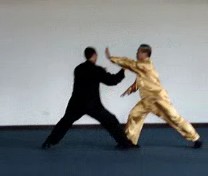
A Pattern for All Occasions!
Many people may not believe that although most of the participants to the the VIP Taijiquan Course at Villa de Leyva in September 2005 did not have any Taijiquan or martial art experience, they nevertheless know how to defend themselves against all forms of attack after their four-day course. But it is true.
If participants know how to defend against some attacks but not others, then the course is incomplete. It is pertinent to mention that “knowing how to defend” is not necessary the same as “being able to defend”. In other words, if a skillful exponent attacks a participant, the participant may fail to defend himself although he knows how to.
This is understandable. Most of the participants have only a few days' experience of martial art. It is unreasonable to expect them to be as combat competent as skillful martial artists who have practiced for years. But if the participants spend some time practicing what they have learnt at the course, they will be combat efficient in a much shorter time than others who learn combat haphazardly. Worse, Taijiquan practitioners who never learn combat application will never be able to use Taijiquan for defence even if they practice solo forms for their whole life.
But how could the participants learn all the defence techniques in just four days when there are countless different forms of attack? The solution lies in the cost-effectiveness of the teaching methodology, an example of which is shown in this video series.
Here participants learned only one Taijiquan pattern to handle all attack situations! In this way, the participants could save a lot of time. They were cost-effective in the following two aspects.
One, they had to learn only one defence technique instead of many. And the technique chosen was “Green Dragon Shoots Pearl”, which could be used to counter all the four different categories of attack. In other words, instead of learning one technique to counter strikes, another to counter kicks, yet another to counter throws, still another to counter grips, the participants used just one technique to counter all these different attacks! Two, once they understood the underlying principles involved in countering a typical attack, they could counter all other similar attacks. For example, once they could counter a right vertical punch executed in a left Bow-Arrow Stance, by making appropriate adjustment they could also counter a left vertical punch, a right palm strike or any other hand forms executed in a right Bow-Arrow Stance, a left False leg Stance or any other stances.
Hua-Jing or Yielding in Taijiquan Combat (1)
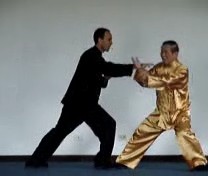
To apply a technique successfully in combat, one must have the necessary skills. Skills in fact are more important than techniques. One essential skill in applying Taijiquan for combat is “hua-jing”, or “neutralizing an opponent's force”, but is commonly known as “yielding”. First you yield to lead the opponent come in. Then using his momentum you deflect and turn it against himself. In many ways, “hua-jing” or yielding is the essence in Taijiquan combat.
Hua-Jing or Yielding in Taijiquan Combat (2)
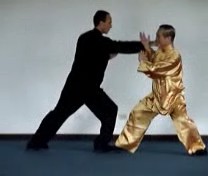
Besides having the correct hand movement in “hua-jing” or yielding, the body movement and the leg movement must also be correct. This is a manifestation of the three external harmonies of hands, body and legs.
Countering Strikes
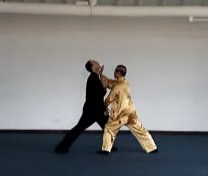
This counter exemplifies two important Taijiquan principles — “Using the opponent's momentum against himself” and “starting later arriving earlier”.
Importance of Coverage
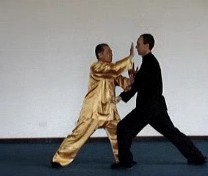
It is essential to “cover” or “close” the opponent when attacking, otherwise he may counter-strike and hurt you. Here the exponent uses one hand to “cover” the opponent's two hands, while attacking with the other hand. This is the principle of “one against two”.
Countering Kicks (1)
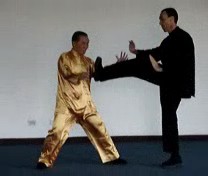
The exponent applies “Green Dragon Shoots Pearl” against the opponent's frontal thrust kick. It does not matter much whether the opponent kicks with his left or right leg. By using appropriate body and leg movements, the exponent avoids the full force of the kick, i.e. “hua-jing” or “yielding”, and counter-strikes before the opponent has recovered himself. Notice how much bigger in size is the opponent over the exponent, indicating that in Taijiquan size is not an important factor.
Countering Kicks (2)
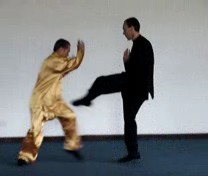
The opponent uses a right whirlwind kick. Using his left hand to block the sweeping kick would be going against the full force of the attack. Hence, the exponent uses his right hand to brush away the kick, so as to flow with the opponent's force, followed with a left palm strike on the opponent's back as the opponent has turned to his other side after the sweeping kick. In friendly sparring, one has to be careful with the palm strike, which may penetrate from the back into the opponent's heart in front, seriously injuring or even killing him.
Counters against Throws
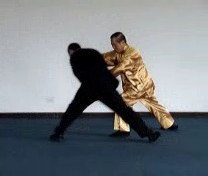
The exponent demonstrates the use of “Green Dragon Shoots Pearl” in countering a backward throw. He changes his right leg in front to become his left leg in front, and "tames" the opponent's hands as he strikes the opponent with the other hand.
Counters against Grips
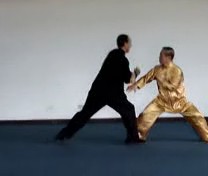
How would you neutralize your opponent gripping your two wrists? “Green Dragon Shoots Pearl” is an effective counter. You turn your two hands over and around the opponent's hands.
A Pattern for All Occasions in Wahnam Taijiquan from Wong Kiew Kit on Vimeo.
LINKS
Courses and Classes
